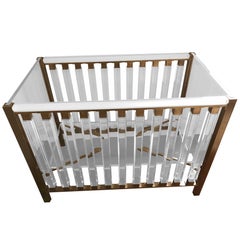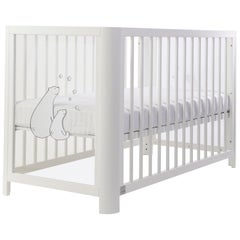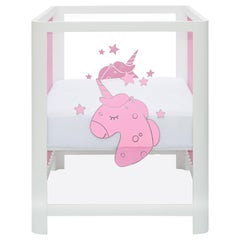Lucite Crib
21st Century and Contemporary American Modern Children's Furniture
Brass
21st Century and Contemporary American Modern Children's Furniture
Brass
Recent Sales
2010s Lebanese Modern Children's Furniture
Acrylic, Wood
2010s Lebanese Modern Children's Furniture
Acrylic, Wood
People Also Browsed
21st Century and Contemporary Italian Modern Sofas
Leather, Wood
21st Century and Contemporary Italian Modern Bookcases
Metal
21st Century and Contemporary French Chandeliers and Pendants
Crystal, Iron
21st Century and Contemporary Modern Dining Room Tables
Marble, Brass
Early 20th Century Italian Rococo Bird Cages
Metal
Early 1900s American Impressionist Landscape Paintings
Oil, Canvas
Antique Early 1900s French Art Nouveau Bird Cages
Iron
Antique 19th Century Irish Armchairs
Upholstery, Yew
21st Century and Contemporary Portuguese Beds and Bed Frames
Wood, Fur
21st Century and Contemporary European Bauhaus Beds and Bed Frames
Marble
2010s British Dry Bars
Walnut
2010s Danish Scandinavian Modern Children's Furniture
Birch, Cotton, Wool
1990s Abstract Sculptures
Silver, Gold Leaf
Antique Late 19th Century French Louis XV Musical Instruments
Wood, Giltwood
Antique Early 19th Century French Charles X Architectural Elements
Stone, Copper
Early 20th Century Swiss More Clocks
Gold
A Close Look at Modern Furniture
The late 19th and early 20th centuries saw sweeping social change and major scientific advances — both of which contributed to a new aesthetic: modernism. Rejecting the rigidity of Victorian artistic conventions, modernists sought a new means of expression. References to the natural world and ornate classical embellishments gave way to the sleek simplicity of the Machine Age. Architect Philip Johnson characterized the hallmarks of modernism as “machine-like simplicity, smoothness or surface [and] avoidance of ornament.”
Early practitioners of modernist design include the De Stijl (“The Style”) group, founded in the Netherlands in 1917, and the Bauhaus School, founded two years later in Germany.
Followers of both groups produced sleek, spare designs — many of which became icons of daily life in the 20th century. The modernists rejected both natural and historical references and relied primarily on industrial materials such as metal, glass, plywood, and, later, plastics. While Bauhaus principals Marcel Breuer and Ludwig Mies van der Rohe created furniture from mass-produced, chrome-plated steel, American visionaries like Charles and Ray Eames worked in materials as novel as molded plywood and fiberglass. Today, Breuer’s Wassily chair, Mies van der Rohe’s Barcelona chair — crafted with his romantic partner, designer Lilly Reich — and the Eames lounge chair are emblems of progressive design and vintage originals are prized cornerstones of collections.
It’s difficult to overstate the influence that modernism continues to wield over designers and architects — and equally difficult to overstate how revolutionary it was when it first appeared a century ago. But because modernist furniture designs are so simple, they can blend in seamlessly with just about any type of décor. Don’t overlook them.
Finding the Right Childrens-furniture for You
When you’re shopping for antique, new and vintage children’s furniture, you’ll want your choices to fit nicely within the decor scheme of the rest of your home. But you’ll also want to create an alluring and inspirational space for your children to feel relaxed and encouraged creatively. Indeed, a child’s room can be simultaneously stylish and playful — the ideal environment for children.
Understandably, beds were the first piece of furniture designed for young children. In Ancient Egypt, children’s beds were scaled-down versions of adult beds. They were intended to be a logical size for a child and low enough to the ground so that they could climb in by themselves.
Historians discovered early high chairs in Ancient Greece. In the 6th century B.C., a child’s training potty might have also been used as a high chair, while archaeologists on a dig discovered a terracotta high chair in a marketplace in Athens. By the Renaissance period, children’s bookshelves were popular with upper-class families who had disposable income and the desire to beautify all areas of the home. The original purpose was to organize school books, but shelves eventually became integral to children’s rooms of the era.
In the early 20th century, Italian physician Maria Montessori changed the way designers thought about children’s furniture. She wrote that it was important for children to have a safe environment of their own that they could easily navigate. Montessori believed that children’s furniture should be sized for them but that it should also be made of light, durable materials so that it’s easy for them to carry if needed.
Today’s widely known mid-century modern furniture designers took interest in the idea that young children should have well-crafted furniture of their own. You can find vintage mid-century modern children’s furniture created by the likes of Harry Bertoia, Charles and Ray Eames and Alvar Aalto. Contemporary industrial designer and architect Philippe Starck is also known for having introduced versions of his furniture that were geared toward children, especially his seating and storage solutions.
It’s never too early for good design. Decorating a child’s room offers the opportunity to combine elevated furnishings and a youthful spirit and can result in spaces that are at once elegant and whimsical. On 1stDibs, find design ideas for children’s rooms as well as a variety of new, antique and vintage children’s furniture today.



